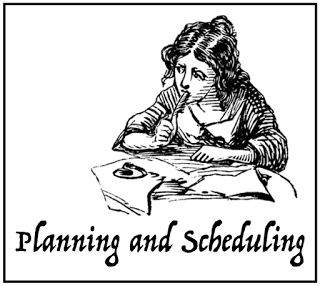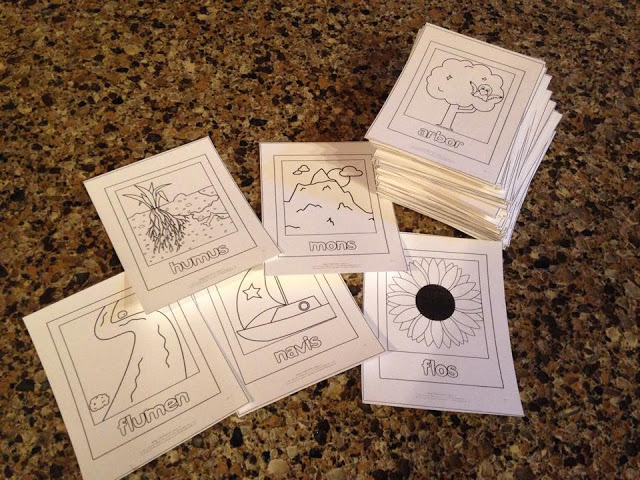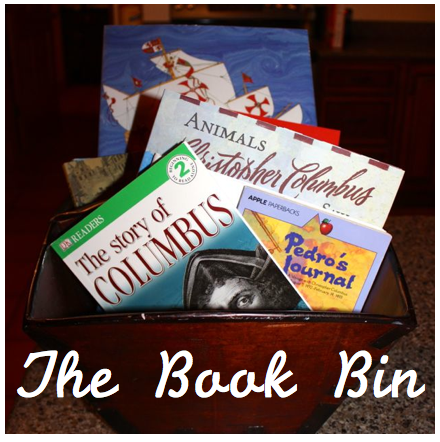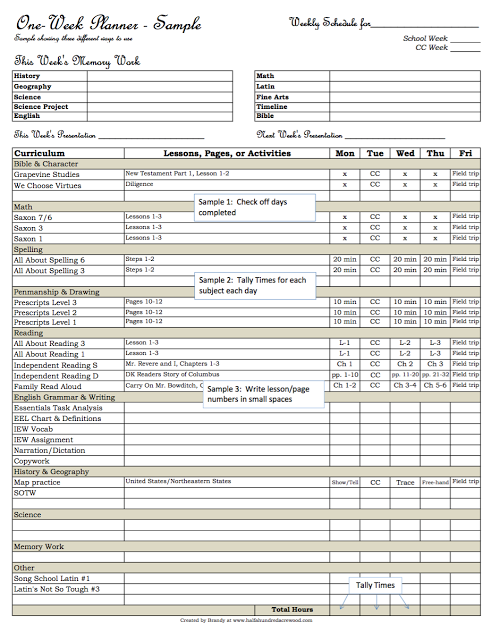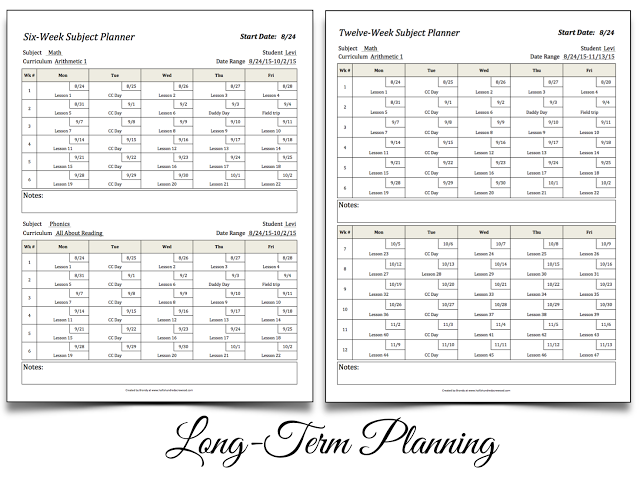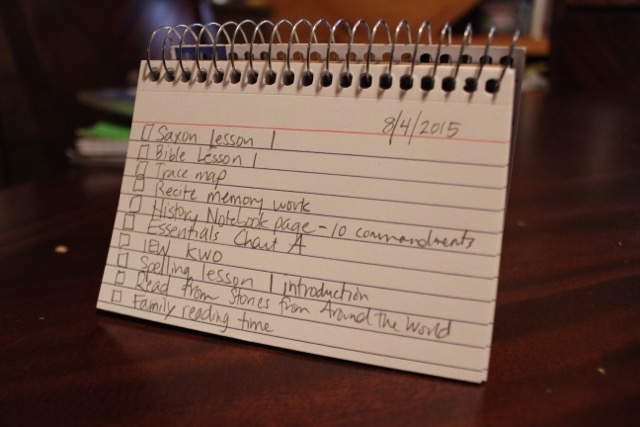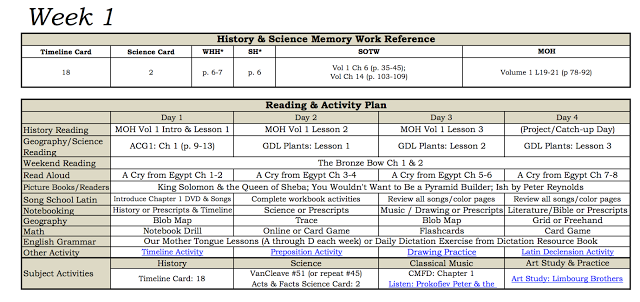In this season of my life, there’s probably nothing more ironic than me trying to explain to others how I plan do anything. In fact, I am hesitant to write my response to the planning questions I’ve received for fear that someone will think I a) have it all together, and b) possess any real words of wisdom. I’m just the same as any other mama – just figuring it all out. There are others that have a much better handle on planning than I do. Although I had hoped to write this up in short bursts throughout the summer, that did not happen. So a word of warning: I’m using the brain dump method here to say everything I can think of about planning as it relates to our family. I’m not sure it even makes sense, but here goes…
When we started our school daze days three weeks ago, little did I know that I would be changing so many gears so quickly. Let’s just say… it’s a question of circumstance. (At least it’s one of the Five Common Topics.)
So, with a toddler in tow, a husband who has been gone nearly all summer, a new Challenge A student, and a community directorship on my hands, I thought I’d share with you how I “get it all done.”
Truth #1: I don’t get it all done. My plans are just that: plans. For example, all of my plans for this summer – the leading of an on-line “bloom” group, the reading and co-leading of a Facebook book club, and all my blogging and article-writing intentions – fell by the wayside due to more pressing responsibilities (like motherhood, teaching my children, and directing a homeschool community). As far as our school year is concerned, starting three weeks early has given me time to do things like… find our missing Song School Latin book (which I didn’t realize was missing), switch to a more engaging math curriculum for Levi (really? Is that even possible?), incorporate a new spelling curriculum for our second son (when I really just want to stick with what we’ve been using), and “taper up” or ramp up to a full-fledged school day (sort of). We faced several setbacks to our school schedule as we juggled Popcorn & Pudewa sessions, family orientation and tutor meeting preparation, and the general blessed chaos of chasing a toddler around the house. Truth is, I’m not sure how we get much of anything done. Progress in our family is an example of God’s grace.
Truth #2: Without “tapering” into the year, I would likely be too discouraged to ever get started. We started our school year with just Bible and math (and our traditional Monkey Bread breakfast). After a few days, we added penmanship, and after about a week, we added in phonics and spelling (which is when I found that David had forgotten most everything he learned last year). After another week, we added in the study of Latin vocabulary cards made from Song School Latin Coloring Pages, which we printed on cardstock, nine pages to a sheet:
After much consideration about how I would like to incorporate more Latin, I’ve opted for cultivating a love of Latin in the early years. Our children really like their new flashcards, along with the Song School Latin DVD, and that’s good enough for me! The “taper up” thing can also be referred to as Pudewa’s EZ+1. Do what’s easy along with one more thing. It sure makes for an easier start to the school year!
Reading is a normal part of our home regardless of whether school is officially “in session,” which brings me to my next point…
Truth #3: We don’t stick to our reading plan. We read books in a manner that’s most convenient for our family, regardless of where I’ve scheduled books into our reading plan. In fact, because we listened to The Mystery of History Volume 1 in the car this summer, we’re less than 5 lessons away from the end of the book. Because of this, we will likely move on to The Mystery of History Volume 2. Over the summer, we also read the first book scheduled on our reading plan, A Cry from Egypt, which was an incredible way to bring the Exodus to life (not to mention the connections between Egyptian and Jewish history)! The boys kept asking me to read “just one more chapter!” I love books like that!
Now that I’ve gotten those three important truths off my chest, I feel like I can share a few other tidbits that might be helpful.
Homeschooling Tips & Tricks
Encouraging more reading. When I want my children to read particular books, I set those books out where they have easy access to them. I’ve found that although it may make for a messier house, if books are not left out, it’s quite possible that they won’t read them. (Out of sight, out of mind.) Same goes for science experiments or any other enrichment activity.
Using our planner pages. In the past, I have not written what we plan to do in my planner. I have written what we actually did in my planner. For those who use one of our checklist-style planners, here are three different examples of what that might look like:
You can use the small boxes to check off as you complete tasks, you can use them to tally times for your records, or you can write in the individual lessons. So, our planning pages ended up being our recording pages.
Long-term scheduling of math/phonics. The only planner pages I use for long-term planning are our six-week and twelve-week subject planners. I use these to get an estimate of where we should be in our math and phonics books by the end of each six-week period. It just helps me with pacing and scheduling breaks into our school year and helps me know how many field trips and rabbit trails we can go down. The following is an example of how I plan long-term, but I don’t actually type it up. I use a pencil and scribble my own made-up abbreviations in the boxes.
For an editable Excel version of this planner (where you can input the starting date and other info), click here.
Using spiral notebooks to plan. This year, instead of using our planner to write our plans, I’m using spiral notebooks to log in each daily task checklist for each of my children. (See this post for more details.) It seems like a lot of work, but it takes less than 10 minutes per day for me to do this for two of my children, and it has been much better than having a daily generic laminated checklist. I have taught our oldest (in middle school) how to do this himself. So what about all the planners? Well… I’m using our Reading Plan Only version (see the next point) as a reference along with our Cycle 1 At-a-Glance Pages. I’m pacing our school year with our six-week and twelve-week subject pages, and that’s about it.
An aside: Oh, how I love having a middle school student! He’s currently learning skills in planning and autonomy, and I’m learning to let go. It’s a wonderful thing to see him maturing (not to mention, the wonderful discussions we’re having!). Even though I miss the early years, this is precious!
Our Reading Plan. At the bottom of our planner pages is our actual “plan.” Again, this is more of a guideline. We don’t do it all. It is my reference for what I’d like to get done over the course of the year. I plan out 24 weeks of reading and activities for our family. We usually complete those 24 weeks over our 36-week school year.
If you’re asking, “How on earth can you possibly do all of that?!?” …before I publish my plans, I actually time myself reading out loud, etc. to ensure it isn’t excessive.
- The Mystery of History lessons usually take less than 10 minutes to read.
- The A Child’s Geography lesson and God’s Design for Life lessons usually take less than 10 minutes to read.
- We usually read our read-aloud before bedtime. Sometimes we read for extended periods over the weekend. I have the boys read some of the picture books and readers out loud to me in the afternoons.
- Song School Latin takes about 10 minutes for us (we focus primarily on DVDs and flashcards).
- Notebooking (handwriting/copywork practice) usually takes less than 15 minutes, and our family mainly just uses Script-n-Scribe.
- Blob mapping and/or tracing takes less than 5 minutes.
- Math drills are incorporated into our Saxon and ABeka lessons, so this is just part of math.
- Our Mother Tongue is an “outloud” lesson I will complete with Levi. It takes 10-15 minutes.
- The Other Activity section is just a way to review memory work. We won’t be too worried about completing these, as we usually practice our memory work by singing the memory work songs and creating visuals like our Timeline Thumbnails or Comic Illustration Pages.
- Subject activities are items I would like to get to each week and will vary according to topic.
- We don’t read the correlated readings from Story of the World unless we are doing research for a presentation.
- (If our reading plan is too aggressive, you can check out the simpler plans here.)
Removing the “weekend reading,” “read aloud,” and “picture books/readers,” it takes about 60-90 minutes to read/do everything on the list. Even so, our family tends to “loop” the Subject Activities and Geography Practice. (In fact, if we ever fall “behind” schedule, we pretty much just pick up where we left off instead of trying to catch up.) Staying on schedule is not nearly as important to me as cultivating wonder and curiosity and a love of learning in my children, which brings me to my next point…
Create a Rhythm, Not a Strict Schedule. Our family has certain tasks I like for us to finish daily, but you will not find us doing the same thing at the same time each day. I create plans to have a structure to reference, but if my children are super-interested in science and ask to extend an experiment, or if they want to imitate or act out something we are reading, or if they find something wonderful and beautiful about mathematics, I ditch the schedule and go with some delight-led learning. If you are new to this concept, you can find out more through the book Plan to Be Flexible (read the review here).
Block Scheduling vs. A Rotating or “Loop” Schedule. Keeping the previous point in my mind, we use a block schedule to put structure to our planning, especially when it comes to our middle school and language arts coursework. We tend to rotate through other subjects in the afternoons. For more details about what rotating or loop scheduling is, visit this post.
Schedule for 1st & 4th Grader
|
Day 1
|
Day 2
|
Day 3
|
Day 4
|
|
| At Breakfast | Reading from our Reading Plan (MOH, ACG, God’s Design for Life) | |||
| Read Timeline Card for current history sentence (See Reading Plan) |
Read Science Card for current Science Fact (See Reading Plan) |
Listen to Classical Music (See Reading Plan) |
Art Study & Practice (in afternoon) | |
| After Breakfast | Bible: Virtue & Lesson Maps & Memory Work Practice |
|||
| Block 1 | Math Assignment / Math Drills | |||
| Block 2 | Spelling/Phonics | |||
| Block 3: 4th grader |
Language Arts IEW – Writing Key Word Outline Vocabulary SRN Grammar Rules |
Language Arts IEW – Writing Rough Draft Vocabulary |
Language Arts IEW – Writing Revise paper Vocabulary |
Language Arts IEW – Writing Final Copy/Mark-up Vocabulary Practice reading paper aloud |
| Grammar Chart practice Task Analysis on 2 sentences Oral Question Confirmation Drill |
Grammar Chart practice Task Analysis on 1 sentence Oral Question Confirmation Drill |
Grammar Chart practice Task Analysis on 1 sentence Oral Question Confirmation Drill |
Grammar Chart practice Task Analysis on 1 sentence Oral Question Confirmation Drill |
|
| Block 3: 1st grader | Copywork | |||
|
Lunch
|
||||
| Block 4 | READING HOUR Independent reading and children read-aloud |
|||
| Block 5 | Latin | Presentation Prep | Latin | Presentation Prep |
| Block 6 (Optional) | History & Geography Activities | Science & Fine Arts Activities | History & Geography Activities | Presentation Prep Science Activities |
| After 3PM and/or on the weekends | Finish anything that was not completed Other family reading (usually before bedtime) Science Investigation and/or Nature Study and/or Fine Arts (as time allows) |
|||
Current Schedule for 7th Grader
|
Day 1
|
Day 2
|
Day 3
|
Day 4
|
|
| At Breakfast | Reading from our Reading Plan (God’s Design for Life, MOH, ACG) | |||
|
Daily Tasks
|
||||
| After Breakfast | Bible Lesson Catechism Recitation Geography Maps & Vocab |
|||
| Block 1 | Math Assignment / Math Drills | |||
| Block 2 | Spelling | |||
| Block 3 | Latin | |||
| Block 4 | Lost Tools of Writing | |||
|
Lunch
|
||||
| Block 5 | Lost Tools of Writing | |||
| Block 5 | Rhetoric | Science KWO & Bibliography | Science Composition | Practice Reading Science Aloud |
| Block 6 | Independent Reading | |||
| After 3PM and/or on the weekends | Finish anything that was not completed Practice Piano and Typing Other family reading or activities |
|||
This will likely be modified as the school year progresses, but our middle school student is finishing everything before 3PM each day, even on his distractible days. My current favorite resource for him is…Visual Latin. It includes such great explanations for each concept in Latin.
Cycle 1 Resources Activity Plan. If you use our Cycle 1 Resources Page (with weekly links to history, science, etc. resources for enrichment activities), here’s an example of how you might plan to use them over the course of a week.
Curriculum Choices. The bulk of our daily work is reading. We love reading and science, so I spend more time incorporating those activities into our school day. I am trying to make more of an effort to incorporate more fine arts study; you’ll find specific composer and art studies referenced in our reading plans.
|
Grade 7
(Challenge A) |
Grade 4
|
Grade 1
|
|
|
CORE SUBJECTS
|
|||
|
Bible
|
Grapevine Studies: New Testament Overview Parts 1-4
|
||
|
Math
|
Abeka Arithmetic 1
|
||
|
Spelling/Phonics
|
All About Spelling Level 7 or Phonetic Zoo (whichever works out better for us)
|
Essentials and Apples
|
|
|
English Grammar & Writing
|
Lost Tools of Writing & Henle Latin (with Visual Latin)
|
Essentials
|
|
|
Reading
|
Our Reading Plan (plus additional independent reading)
|
||
|
Latin
|
Henle Latin (with Visual Latin)
|
Song School Latin 1 DVD (Review)
Song School Latin 2 DVD and book (Introduce)
|
Song School Latin 1 DVD (Review)
Song School Latin 2 DVD (Introduce)
|
|
All Subjects – Memory Work and Making Connections
|
Daily map tracing and/or blobbing practice
|
||
|
LAGNIAPPE
|
|||
|
History
|
Classical Acts & Facts History Cards (for reference)
Refer to our Cycle 1 Reading Plan for our read aloud selections
|
||
|
Science & Subject Integration |
Refer to our Cycle 1 Reading Plan
Classical Acts & Facts Science Cards (for reference)
First Semester:
Second Semester:
Both Semesters (Science + Geography + Missions + History):
|
||
Why did I switch Levi from Saxon to Abeka? Well, I’m not particularly fond of the grades 1-3 Saxon books, so when he begged to use a book like Stephen did his first grade year (which is still sitting on our shelves), I looked ahead to the Abeka 3 book to see if it would transition well into Saxon 5/4 when he gets to 4th grade. It will be just fine, so I said yes. He is excitedly doing his math every day now, and I can breathe a sigh of relief.
After testing poorly on last year’s spelling words, David is on hold with All About Spelling, and we are using a few other resources to see if it helps bridge the gap in his learning. Everything else is pretty routine for our family, and I am so pleased with our reading selections this year – more than I have been in any other year. This year is going to be fantastic!

